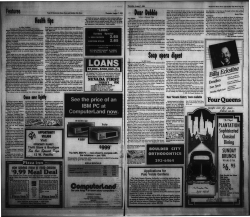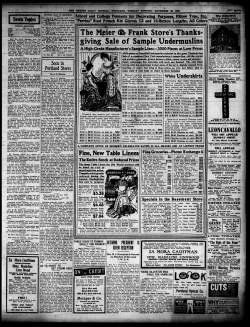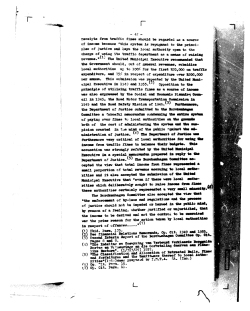
SA 20.6: 5GSample/s Track-Hold and 3GSample/s Quasi-Sample-Hold ICs A. Hülsmann, T. Jakobus
SA 20.6: 5GSample/s Track-Hold and 3GSample/s Quasi-Sample-Hold ICs Z. Lao, A. Thiede, H. Lienhart, M. Schlechtweg, W. Bronner, J. Hornung, A. Hülsmann, T. Jakobus of 30ps, necessary for short transition times between the two operating modes. Fraunhofer-Institute of Applied Solid-State Physics, Freiburg, Germany The quasi-sample-and-hold amplifier (quasi-SHA) samples the input signal for a short time and holds the sampled value for the duration of the duty cycle. The main difference between THA and quasi-SHA lies in the switch driver circuit. Instead of abroad-band amplifier, a static frequency divider followed by a NAND gate are applied to form a pulse with a 1/4 of the period for tracking and 3/ 4 for holding. Two fully-differential track-and-hold and quasi-sample-and-hold circuits are based on AlGaAs/GaAs-HEMTs with 60GHz fT. The less complex of these circuits exhibits 7b linearity measured under worst case. The ICs work up to 5GSample/s at a differential input of 2Vp-p for the track-and-hold and 3GSample/s for the quasisample-and-hold. The THA can be directly merged with the sourcefollower input stage of a A/D converter and is also suitable for Si bipolar technology. There are different approaches to THA circuits, but the highspeed differential THAs is usually that proposed by P. Vorenkamp [1-6]. While operating up to 1GSample/s [2, 3], the input buffer required in this approach distorts the linearity of the original input signal [2-6]; and the bias voltage of the series linearization diode limits the input voltage swing to 1Vp-p at -5V supply [3, 6]. The design presented is an evolution of above mentioned THA [6]. The THA exhibits high linearity, small pedestal error, large inputvoltage range and a high-sampling rate. It consists of the input stage that operates as a switched source follower sampler, the switch driver and the output buffer. Differential configuration is used throughout the design to improve overall linearity, minimize common-mode pedestal and noise, and reduce effective droop rate. Figure 1 depicts the principle THA. The transistor Q has a high impedance to the signal source and provides a current gain to charge the hold capacitance CH. The switches S1 and S2 are controlled by the clock signal to track the input signal when they are on or retain the last value of the input signal when they are off. The circuit of Figure 2 is a fully differential implementation of the circuit shown in Figure 1. The transistor Q1 (Q1') with resistance Rs (Rs’) represents the switch S1, and transistors Q2 (Q2') - Q3 (Q3') the switch S2 in Figure 1, respectively. During the track mode (when node T is high), transistors Q (Q’) and Q1 (Q1') act as twostage source-followers charging and discharging the hold capacitance CH (CH’). The two cascaded source-followers improve the decoupling capability and provide efficient drive for the hold capacitance. During the hold mode (when node H is high), the current I0 (I0') is switched away from the transistor Q1 (Q1') and flows across resistor Rs, causing an additional voltage drop of approximately 1V. Q1 (Q1') is now reverse biased and the holdcapacitance CH is isolated from input signal. The maximum input voltage swing is determined by I0 Rs + ∆Vgs(Q) and the Rs by the time constant τ1 ≈ (1/gm(Q)+ Rs)(Cgd(Q1)+ Cds(Q2)). τ1 should be smaller than τ2 ≈ (1/gm(Q1))(CH+ Cgd(Q3)+ Cds(Q3)+ Cgd(Q4)), which represents the analog bandwidth of the THA. In this design, Rs = 200Ω, Is1 = 0.8mA, I0 = 4mA and CH = 1 pF. An another important function of Rs it to prevent ringing during the track phase. It effectively dampens the negative impedance caused by the source-followers with their large hold capacitance CH. This results in minimizing the pedestal error and transient settling time. Providing an on-chip switch driver and an output buffer (Q 4-Q6, Q4'-Q6') facilitates IC test. The output buffer offers a high impedance to the hold capacitance to keep the held voltage from discharging. The switch driver converts a 500mVp-p sine wave input voltage into an approximately rectangular signal by which the hold capacitance is alternately switched between track and hold. This is achieved by a broadband amplifier with a differential active source-follower [7]. The resulting switch-pulse has a rise/fall-time © IEEE 1998 Figure 4 is a micrograph of the 0.7x0.9mm2 THA IC chip. It is based on 0.2µm gate length enhancement and depletion AlGaAs/GaAsHEMTs (fT = 60 and 50GHz) [8]. The circuits are measured on wafer using 50Ω coplanar test probes. Figure 5 shows the measured performance at 5GHz sampling rate at a sine-wave input of 500MHz and an input amplitude of 2Vp-p. This is the highest sampling rate reported in any technology. The THA output is fed directly into a spectrum analyzer. Figure 6 shows the measured spectrum of a 2.5GHz analog input sampled by a 2.501GHz clock. The resulting 1MHz beat frequency is then analyzed for distortion, which is found to be better than -45dB. This corresponds to 7 effective bits. The actual linearity is better than this value because the circuit operates under the worst condition at a frequency of 2.5GHz above the Nyquist rate and the nonlinear slewing take place during the track time and hold “edges” of the signal waveform [1]. The pedestal error is approximately 2mV. Figure 7 shows measured performance of the quasi-SHA at 250MHz input signal and 6GHz clock. The actual sampling rate is 3GSample/s due to the function of the switch driver. The power dissipation is 500mW for the THA and 550mW for the quasi-SHA with a single power supply voltage of 5V. Table 1 summarizes performance of the THA circuit. Acknowledgments: The authors thank G. Weimann for encouragement and the entire process laboratory staff for circuit processing. References: [1] Razavi, B., “Design of Sample-and-Hold Amplifiers for High-Speed Low-Power A/D Converters,” IEEE CICC, Digest of Technical Papers, pp. 59-66, 1997. [2] Baumheinrich, T., et al., “A 1GSample/s 10b Full Nyquist Silicon Bipolar Track&Hold IC”, ISSCC Digest of Technical Papers, pp. 142-143, Feb., 1997. [3] Pregardier, B., et al., “A 1GSample/e 8b Silicon Bipolar Track & Hold IC,” ISSCC Digest of Technical Papers, pp. 58-59, Feb., 1995. [4] Karanicolas, A., “A 2.7V 300Msample/s Track-and-Hold Amplifier,” ISSCC Digest of Technical Papers, pp. 140-141, Feb., 1997. [5] Fiocchi, C., et al., “A 10b 250MHz BiCMOS Track and Hold,” ISSCC Digest of Technical Papers, pp. 144-145, Feb., 1997. [6] Vorenkamp, P., et al., “Fully Bipolar, 120MS/s 10b-Track-and-Hold Circuit”, IEEE JSSC, vol. 27, pp. 988-992, 1992. [7] Lao, Z., et al., “25Gb/s AGC Amplifier, 22GHz Transimpedance Amplifier and 27.7GHz Limiting Amplifier ICs using AlGaAs/GaAsHEMTs,” ISSCC Digest of Technical Papers, pp. 356-357, Feb., 1997. [8] Jakobus, T., et al., “Stability of an AlGaAs/GaAs/AlGaAs E/D-HEMT process with double pulse doping,” Int. Symp. GaAs and Related Compounds, Inst. Phys. Conf. Ser. no. 129, Chapter 11, pp. 887-892, 1992. 20.6-1 Figure 1: Block diagram of the principle THA. Figure 3: Principle diagram of the switch driver for the quasi-sample-hold operations. Figure 2: Schematic diagram of the differential THA. Figure 5: Measured performance of the THA Sampling frequency Analog bandwidth Differential analog input range Feedthrough (at fin=2.5GHz) Droop rate Pedestal Slew rate Harmonic distortion (at fin=2.5GHz, fclk=2.501GHz) Voltage swing of clock signal Supply voltage Power dissipation Chip size Figure 6: Measured output spectrum © IEEE 1998 Table 1: 5GSample/s 3GHz 2Vp-p -30dB 1.8mV/ns 2mV 10.7V/ns -45dB 500mVp-p -5V 500mW 0.7x0.9mm2 Performance characteristics of the THA IC. 20.6-2 SA 20.6: 5GSample/s Track-Hold and 3GSample/s Quasi-Sample-Hold ICs Figure 7: Measured performance of the quasi-SHA at fclk= 6 GHz and Vin = 2Vp-p. Figure 4: THA IC chip micrograph. © IEEE 1998 20.6-3 Figure 1: © IEEE 1998 Block diagram of the principle THA. 20.6-4 Figure 2: © IEEE 1998 Schematic diagram of the differential THA. 20.6-5 Figure 3: © IEEE 1998 Principle diagram of the switch driver for the quasi-sample-hold operations. 20.6-6 Figure 4: © IEEE 1998 THA IC chip micrograph. 20.6-7 Figure 5: © IEEE 1998 Measured performance of the THA 20.6-8 Figure 6: © IEEE 1998 Measured output spectrum 20.6-9 Figure 7: © IEEE 1998 Measured performance of the quasi-SHA at fclk= 6 GHz and Vin = 2Vp-p. 20.6-10 Sampling frequency Analog bandwidth Differential analog input range Feedthrough (at fin=2.5GHz) Droop rate Pedestal Slew rate Harmonic distortion (at fin=2.5GHz, fclk=2.501GHz) Voltage swing of clock signal Supply voltage Power dissipation Chip size Table 1: © IEEE 1998 5GSample/s 3GHz 2Vp-p -30dB 1.8mV/ns 2mV 10.7V/ns -45dB 500mVp-p -5V 500mW 0.7x0.9mm2 Performance characteristics of the THA IC. 20.6-11
© Copyright 2025
















